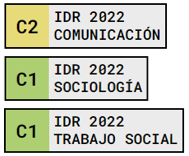Values perception in food commercials with dietary strategies
Keywords:
Eating disorders, commercials, values, media, advertising literacyAbstract
There is clear evidence today that advertising influences eating disorders. Particularly, advertising uses stereotyped body images to spread and promote physical ideals and non-healthy food habits associated with food and clothes products targeted at youth. The purpose of this is study is to test the perception of 25 values in three dietary commercials by two groups of young people (with and without eating disorders). Results show that only the group with those disorders (ED) consider these commercials to be negative in terms of health, well-being, family or effort, while the non-ED group assesses them slightly positively. These results point to the unnatural and self-interested social and media construction of beauty and success.
La percepción de valores en los anuncios de comida con estrategia dietética
Resumen
En la actualidad, existe consenso son la influencia de la publicidad en los trastornos alimentarios. En particular, la publicidad utiliza imágenes corporales estereotipadas para extender y promocionar ideales físicos y hábitos alimentarios no saludables asociados con productos de comida y ropa dirigidos a jóvenes. El objetivo de este estudio es testar la percepción de 25 valores in tres anuncios dietéticos por parte de dos grupos de jóvenes participantes (con y sin trastornos alimentarios). Los resultados muestran que sólo el grupo con trastornos (ED) considera que estos anuncios son negativos para la salud, el bienestar, la familia y el esfuerzo, mientras que el grupo sin trastornos alimentarios los evalúa de forma ligeramente positiva. Estos resultados apuntan a una construcción mediática poco natural e interesada de los cánones de belleza y éxito.
Downloads
References
Andrews, J. C. (1989). The dimensionality of beliefs toward advertising in general. Journal of advertising, 18(1), 26-35. doi:10.1080/00913367.1989.10673140
Bell, B. T., Lawton, R., and Dittmar, H. (2007). The impact of thin models in music videos on adolescent girls’ body dissatisfaction. Body Image, 4(2), 137- 145
Bernárdez Rodal, A. (2009). Representaciones de lo femenino en publicidad. Muñecas y mujeres: entre la materia artificial y la carne. CIC: Cuadernos de Información y Comunicación, (14), 269-286.
Bittencourt, L., and Almeida, R. A. (2013). Transtornos alimentares: patologia ou estilo de vida? Psicologia and Sociedade, 25(1), 220-229
Botta, R. A. (1999). Television images and adolescent girls' body image disturbance. Journal of communication, 49(2), 22-41. doi:10.1111/j.1460-2466.1999.tb02791.
Bourdieu, P. (1984). Distinction: A social critique of the judgement of taste. Harvard University Press.
Boyland, E. J., Harrold, J. A., Kirkham, T. C., Corker, C., Cuddy, J., Evans, D., and Halford, J. C. (2011). Food commercials increase preference for energy-dense foods, particularly in children who watch more television. Pediatrics, 128(1), e93-e100. doi:10.1542/peds.2010-1859
Byrd-Bredbenner, C., and Grasso, D. (2000). What is television trying to make children swallow?: content analysis of the nutrition information in prime-time advertisements. Journal of Nutrition Education, 32(4), 187-195. doi:10.1016/S0022-3182(00)70556-5
Cáceres Zapatero, M. D. and Díaz-Soloaga, P. (2008). La representación del cuerpo de la mujer en la publicidad de revistas femeninas. Estudios sobre el mensaje periodístico, (14), 309-327.
Carreras Port, A. (2011). Coeducar des del bressol; La construcció de les identitats de gènere a la primera infancia. Barcelona: Diputació de Barcelona.
Carrillo, M. V., Jiménez-Morales, M., and Sánchez, M. (2013). Medios de comunicación y culto al cuerpo. Pearson.
Casalé, A., and Añaños, E. (2013). “Efectos de la publicidad alimentaria y estética corporal en los sujetos con trastorno de la conducta alimentaria”. Ph.D. Dissertation, Department of Psychology, Universidad Autónoma de Barcelona, Spain.
Castro, Y. R., Otero, M. C., Prieto, M. F., and Fernández, M. L. (2003). Hábitos alimentarios e imagen corporal en estudiantes universitarios sin trastornos alimentarios. Revista internacional de psicología clínica y de la salud= International journal of clinical and health psychology, 3(1), 23-33.
Chinchilla, A., Calvo, R., Rodríguez, B., and Zamarron, I. (1994). Anorexia y bulimia nerviosas. Ergon. Madrid.
Díaz, C. G. (2008). La categoría de producto y el mensaje transmitido. Revista Latina de comunicación social, (63), 41. doi:10.4185/RLCS-63-2008-798-480-491
Díaz-Soloaga, P., Quintas Froufe, N. and Muñiz, C. (2010). Cuerpos mediáticos versus cuerpos reales. Un estudio de la representación del cuerpo femenino en la publicidad de marcas de moda en España. Revista Icono 14, 244-256.
Drumwright, M. E., and Murphy, P. E. (2004). How advertising practitioners view ethics: moral muteness, moral myopia, and moral imagination. Journal of Advertising, 33(2), 7-24. doi:10.1080/00913367.2004.10639158
Field, A. E., Cheung, L., Wolf, A. M., Herzog, D. B., Gortmaker, S. L., and Colditz, G. A. (2003). Exposure to the mass media and weight concerns among girls. Pediatrics [serial online]. 1999; 103: e36.doi:10.1542/peds.103.3.e36
Grabe, S., Ward, L. M., and Hyde, J. S. (2008). The role of the media in body image concerns among women: a meta-analysis of experimental and correlational studies. Psychological bulletin, 134(3), 460. doi:10.1037/0033-2909.134.3.460
Gracia Arnaiz, M. I. (2006). Género,” dieting” y salud un análisis transcultural dela incidencia de los trastornos del comportamiento alimentario entre las mujeres. Madrid: Instituto de la Mujer.
Groesz, L. M., Levine, M. P., and Murnen, S. K. (2002). The effect of experimental presentation of thin media images on body satisfaction: A meta-analytic review. International Journal of Eating Disorders, 31(1), 1-16. doi:10.1002/eat.10005
Grunert, S. C. (1989). Ein inventar zur erfassung von selbstaussagen zum ernährungsverhalten. Diagnostica, 35(2), 167-79.
Grunert, S. C. (1991). The Influence of Values on Compensatory Eating Behaviour. British Food Journal, 93(9), 4-9. doi:10.1108/00070709110007413
Halliwell, E., and Dittmar, H. (2004). Does size matter? The impact of model's body size on women's body-focused anxiety and advertising effectiveness. Journal of Social and Clinical Psychology, 23(1), 104-122. doi:10.1521/jscp.23.1.104.26989
Hargreaves, D. A., and Tiggemann, M. (2004). Idealized media images and adolescent body image: “Comparing” boys and girls. Body image, 1(4), 351-361. doi:10.1016/j.bodyim.2004.10.002
Harper, B., and Tiggemann, M. (2008). The effect of thin ideal media images on women’s self-objectification, mood, and body image. Sex Roles, 58(9 10), 649-657. doi:10.1007/s11199-007-9379-x
Harrison, K., and Cantor, J. (1997). The relationship between media consumption and eating disorders. Journal of Communication, 47, 40-67. doi:10.1111/j.1460-2466.1997.tb02692.x
Harrison, K., and Marske, A. L. (2005). Nutritional content of foods advertised during the television programs children watch most. American Journal of Public Health, 95(9), 1568. doi:10.2105/AJPH.2004.048058
Jiménez Morales, M. (2006). De l’estereotip publicitari adult a la realitat preadolescent. Influència de la publicitat en els trastorns del comportament alimentari en nens i nenes de 8 a 12 anys. Ph.D. Dissertation, Deparment of Communication. Pompeu Fabra University.
Kahle, L. R., Beatty, S. E., and Homer, P. (1986). Alternative measurement approaches to consumer values: the list of values (LOV) and values and life style (VALS). Journal of consumer research, 405-409.
Kelly, B., Halford, J. C., Boyland, E. J., Chapman, K., Bautista-Castaño, I., Berg, C. and Summerbell, C. (2010). Television food advertising to children: a global perspective. American Journal of Public Health, 100(9), 1730-1736. doi: 10.2105/AJPH.2009.179267
Lage A. (2013). “Estereotipos visuales femeninos en la fotografía publicitaria en los productos dirigidos a la apariencia de mujer en las revistas de moda”. Ph.D. Dissertation, Department of Psychology, Universidad Autónoma de Barcelona, Spain.
Lane, S. R., and Fisher, S. M. (2015). The influence of celebrity chefs on a student population. British Food Journal, 117(2), 614-628. doi.org/10.1108/BFJ-09-2013-0253
Levine, M. P., and Murnen, S. K. (2009). “Everybody knows that mass media are/are not [pick one] a cause of eating disorders”: A critical review of evidence for a causal link between media, negative body image, and disordered eating in females. Journal of Social and Clinical Psychology, 28(1), 9-42. doi: 10.1521/jscp.2009.28.1.9
Lobstein, T. (2008). Cereales peligrosos: La verdad sobre la publicidad de alimentos dañinos dirigidos a los niños. London: Consumers International.
Maslow, A. H. (1987). Motivation and personality (revised by R. Frager, J. Fadiman, C. McReynolds, and R. Cox). NY: Harper and Row.
Montoya Vilar, N., Rodríguez Bravo, A., and Mas Manchón, L. L. (2012). “XXXV congresso Brasileiro de ciências da comunicação”. Calidad y evaluación de valores en la comunicación: Construcción de un inventario de valores para España y Brasil, September 2nd-6th, Recife, Brasil.
Nemeroff, C. J., Stein, R. I., Diehl, N. S., and Smilack, K. M. (1994). From the Cleavers to the Clintons: Role choices and body orientation as reflected in magazine article content. International Journal of Eating Disorders, 16(2), 167-176.
Pichot, P., López-Ibor Aliño, J. J., and Valdés Miyar, M. (1995). Trastorno obsesivo-compulsivo. A: DSM-IV. Manual diagnóstico y estadístico de los trastornos mentales. Barcelona: Masson, 428-434.
Pollay, R. W. (2000). The distorted mirror: Reflections on the unintended consequences of advertising. Advertising and Society Review, 1(1). doi:10.1353/asr.2000.0012
Prendergast, G., West, D. C., and Yan, L. K. (2015, January). “Eating Disorders–The Role of Advertising and Editorial”. pp. 175-178 in Proceedings of the 2002 Academy of Marketing Science (AMS) Annual Conference, edited by Springer International Publishing.
Quero Mohamed, S. (2008). Nuevas propuestas educativas: Salud y Valores. Ceuta: Centro de Profesores y Recursos de Ceuta.
Rodríguez Bravo, Á., Montoya Vilar, N., Mas Manchón, Ll., Morales Morante, F., Lopes da Silva, E. A., Martins, G., Peixoto, M. and Müller, K. (2013). Medición y evaluación de valores en contenidos audiovisuales desde un abordaje interdisciplinar. Prisma social: revista de ciencias sociales, pp. 158-204.
Rokeach, M. (1973). The nature of human values (Vol. 438). New York: Free press.
Sánchez, J. E. (2001). Valores, actitudes y habilidades en la educación para la salud. Educación XX1, 4(1).
Scherman, A., Arriagada, A., and Valenzuela, S. (2015). Student and environmental protests in Chile: The role of social media. Politics. doi: 10.1111/1467-9256.12072
Schwartz, S. H. (1996). Applying of theory of integrated value systems: Value priorities and behavior. In The psychology of values: The Ontario Symposium (Vol. 8, pp. 1-24).
Soriano, J., and Sedó, V. (2008). Trastornos de la conducta alimentaria. Bioètica and debat: tribuna abierta del Institut Borja de Bioètica, 14(52), 9-12.
Tufte, B. (2007). Children, media and consumption: on the front edge. Nordicom.
Van Strien, T., Frijters, J. E., Bergers, G., and Defares, P. B. (1986). The Dutch Eating Behavior Questionnaire (DEBQ) for assessment of restrained, emotional, and external eating behavior. International Journal of Eating Disorders, 5(2), 295-315. doi: 10.1002/1098-108X(198602)5:2<295
Vaterlaus, J. M., Patten, E. V., Roche, C., and Young, J. A. (2015). Getting healthy: The perceived influence of social media on young adult health behaviors. Computers in Human Behavior, 45, 151-157. doi:10.1016/j.chb.2014.12.013
Downloads
Published
How to Cite
Issue
Section
License
Those authors who publish in this journal accept the following terms:
-
Authors retain copyright.
-
Authors transfer to the journal the right of first publication. The journal also owns the publishing rights.
-
All published contents are governed by an Attribution-NoDerivatives 4.0 International License.
Access the informative version and legal text of the license. By virtue of this, third parties are allowed to use what is published as long as they mention the authorship of the work and the first publication in this journal. If you transform the material, you may not distribute the modified work. -
Authors may make other independent and additional contractual arrangements for non-exclusive distribution of the version of the article published in this journal (e.g., inclusion in an institutional repository or publication in a book) as long as they clearly indicate that the work was first published in this journal.
- Authors are allowed and recommended to publish their work on the Internet (for example on institutional and personal websites), following the publication of, and referencing the journal, as this could lead to constructive exchanges and a more extensive and quick circulation of published works (see The Effect of Open Access).


















